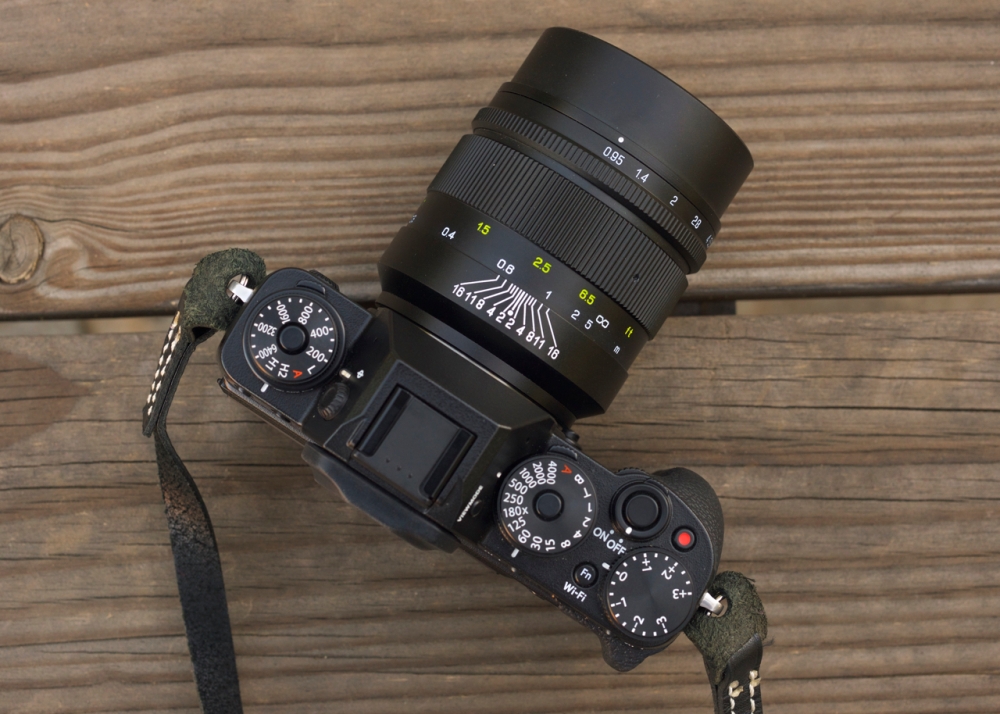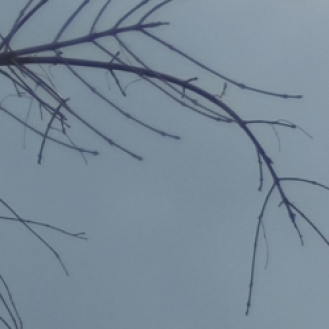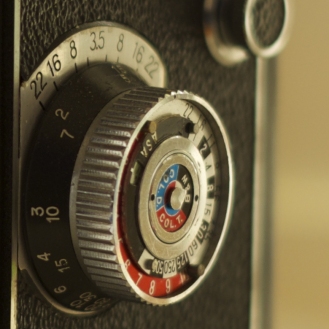You may or may not have heard about this odd little lens that is among the fastest lenses available in a native Fuji X mount. It’s a 35mm f/0.95 hyper prime made by a company in China called Mitakon. There’s a shortage of information on this lens, especially in regards to Fuji X cameras. This post is going to focus on the usability and image quality of this prime lens and hopefully provide enough information for you to decide if it’s a good lens to add to your own kit. I’m a sucker for fast glass. In my line of work, I’ve seen it all (including the famed Kubric lens) which just leaves me lusting for the fastest lenses I can find. This is one of the reasons I strongly prefer primes over zooms. Achieving a high transmission value with zoom lenses is much, much more difficult than it is with primes. Considering this lens is relatively high priced, I’ll do my best to provide information from different points of view. If at the end of this post you still have any questions, feel free to drop them in the comments and I’d be happy to update as needed.

So let’s get to it – the ultra fast aperture is what makes this lens so interesting to most shooters. If you simply want a 35mm, don’t hesitate to pick up Fujifilm’s great little XF 35mm F1.4 Lens. It’s lightweight, compact, and fast. The only lens that Fuji makes that’s faster is the XF 56mm f/1.2. But what if you want to go a bit faster? Enter: the Mitakon 35mm f/0.95. An all manual, Chinese made prime lens. Let’s explore the manufacturer a bit first. You may or may not have heard of Mitakon – or SLR Magic – or ZY Optics… They’re all practically the same. Something you have to remember is that there’s a slight difference between a lens brand and a lens manufacturer. A good example that you may be more familiar with is Samyang, Rokinon, Bower, etc. All of these lenses come from the same factory, but are sold to and under different brands. This isn’t uncommon at all these days. Those beautiful Zeiss SLR primes? Yup… those are made by Cosina in Japan. So don’t let the weird, foreign name throw you off. That said, you should proceed with a healthy dose of caution. Historically, Chinese made lenses do suffer from poor quality control and low tolerances. Fortunately, with this particular lens, you don’t have to worry too much – It’s designed and built relatively well.

The body is all aluminum, anodized black. The mount on my lens is also black anodized aluminum – but in other product photos including Amazon’s, the mount appears to be nickel plated brass. I don’t think one is particularly better than the other, just typical Chinese variations. The focus distance marks are engraved and paint filled (rather poorly). The front filter thread is a common 58mm diameter. This lens is entirely passive meaning there is not communication between the lens and camera in terms of data. Focus and iris are completely manual – I’ll get into that in a bit. Mitakon claims a minimum focus of 11.8″ but the focus scale stops sharp at the engraved 1′ mark. I suppose you could consider the depth of focus at f/16 an additional 4″ as part of the “minimum focus”. The optics are comprised of 10 elements in 7 groups, 6 low-dispursion elements. For those of you who think that 35mm Full Frame (24×36) is the standard by which other cameras are measured, then this petty APS-C lens will offer the equivalent of a 52.5mm. For those of you who know better, this lens offers a horizontal angle of view of approximately 37.34°. The lens is rather hefty thanks to the materials (brass focus helix, aluminum body) weighing in at 1.5 lbs which is half a pound more than the Fujifilm X-T1 camera itself! Don’t be fooled by other reviews that claim excessive weight = high build quality. This lens is not “built like a tank”. Any sudden rendezvous with the earth below and it’s scrap metal. I assure you if this lens is dropped, the focus movement will bind and you’ll be hard pressed to find anyone who will service this lens state-side. Here’s some quick samples comparing the size to the Fuji 35mm which weighs in at 0.4 lbs, 1/3 the weight of the Mitakon…
Now that we have most of the tech specs out of the way – let’s get into the practical portion of this review. Manual focus lenses… It’s super quick and easy with a split prism or other focus aids but it really isn’t very easy with most current cameras – especially with lenses that offer a fake manual focus. Even Fuji’s own “manual” focus lenses use a motor that’s driving the focus group of the lens. Disengage your lens from the camera and that manual focus ring doesn’t actually do anything. With this Mitakon, what you see is what you get. It’s very similar to using a vintage Leica or Zeiss lens in that your focus is direct and true. I’ve had an absolute blast focusing this lens with very few missed shots. I attribute this to two primary factors – the X-T1 and it’s multiple focus aids that really do make manual lenses a dream, and the focus movement of the Mitakon. It’s not a super expanded throw which allows me to rack a quick, rough focus, then fine tune in a second or less. I do get back to my computer and find a few shots with focus just barely in front of or behind my intended subject every now and again, but for the most part – the manual focus is great and setup rather conveniently.

I really, really enjoy shooting with this lens wide open. After all, why else would you spend this kind of money only to shoot at f/1.4 or slower? Right? Prior to Fujifilm’s most recent firmware update, the maximum shutter speed of the X-T1 was 1/4000th of a second which meant that shooting outdoors, even at ISO 200, required stopping down quite a bit. I’d spent a good amount of time shooting outdoors with the Mitakon and a B+W 58mm XS-Pro Vario ND filter just to be able to control my exposure and keep the lens wide open. When I heard that the firmware update included a maximum shutter speed of 1/32000th of a second, all I could think about was shooting wide effing open, in broad daylight, without any neutral density requirements! Imagine that. Direct sunlight, mid day, f/0.95, no problem. The increased shutter speed thanks to the electronic shutter makes this lens even more of a great match with the Fuji X system.
Back to some of the mechanics: the focus movement is well lubricated, with a degree of viscosity on the lighter side which makes for quick yet accurate focus adjustments. The aperture movement uses a much, much heavier lubrication making the rotation quite slow and sticky. Normally, I would consider this a design/manufacturing flaw, but the fact that the aperture ring is directly in front of the focus grip which is constantly being manipulated, I’m going to say that the stiff aperture is a very good choice. I can set the aperture where I want it and not have to worry about nudging it accidentally while racking focus back and fourth. The focus movement is a traditional helix design which moves the entire optics core further and closer from the film plane. Nothing wrong with this at all, but it means that the lens telescopes in and out while focusing.
Let’s get into some of the image quality aspects of this lens. There’s no question here – this lens has it’s flaws. There’s a good amount of fringing in both spherical and chromatic flavors. Most of this can be reduced by stopping down to about f/1.8 and nearly eliminated by f/2.8. You can still see some coma even when stopped down, but it’s not too bad. The bokeh, and there’s a whole lot of it, is beautiful and smooth. The specular highlights in low-light conditions can tend to suffer from some of that coma I mentioned a second ago, especially in the corners which will give your bokeh balls an odd shape. The focus falloff is gradual and consistent especially with the close-focus shallow depth of field. Vignetting can tend to add a good amount of character to the images if you’re into that kind of thing – which I am. Vignetting on this lens is best described as more of a illumination fall-off. I say this because it doesn’t just clip into the image. The exposure gradually and evenly decreases from the center to the edge when shooting wide open. The illumination fall-off is practically gone by the time you stop down to f/2.8. I did also notice a slight amount of color shift when shooting wide open – nothing that can’t be tweaked in post after the fact. Let’s get to some examples.
Looking at the flowers above shot at decreasing aperture, I did a series of photos in the following order, f/0.95, f/2.8, and f/8.0. At first glance, you’ll notice the primary difference is the depth of field. The focus point was the center of the top rose. Note the gradual focus falloff with depth, all the way back to the shutters behind the flowers. Upon closer inspection, cropped in, you’ll start to see that there’s some pretty severe image degradation in terms of overall resolution and contrast as well as some of the fringing we covered earlier. Perhaps it’s just the subject matter here, but the soft focus at wide-open gives the image a distinct romantic fee, reminiscent of a Pro-Mist filter. Take a look:
This close-up crop of the rose really illustrates how the aperture effects overall image quality with this lens. Here’s another series, also shot in the same sequence: f/0.95, f/2.8, and then f/8.0. This series emphasizing more of the illumination fall-off and fringing in the center as well as the corners. Let’s take a look at the full photo first:
The full tree photo here shows the slight color change I mentioned previously at f/0.95. Perhaps it’s just me, but the photo at f/0.95 appears to be quite a bit cooler in color cast than the other two which were only shot a few seconds apart. Overall, the three photos appear acceptable. But punching in, we’ll see some flaws really start to show. Here’s a crop from the left side of the photo. There isn’t a huge difference between f/2.8 and f/8.0, but wide open at f/0.95 there’s some pretty substantial sharpness issues.
So there you have the telling photos that really stress the lens. That said – I’ve really enjoyed shooting with this lens over the past few weeks. Of course it has it’s flaws. But what do you expect from an ultra-fast, manual focus prime lens from China. I’m sure there will be a ton of X shooters who would balk at this lens. After all, on paper it’s not a very attractive option. It’s heavy, it lacks auto focus, it’s expensive, it produces images littered with flaws, and the list goes on. But it’s still such a pleasure to shoot with. It brings me back to my early days of photography and encourages me to take a split second more to confirm that I’ve nailed focus – and maybe I didn’t, but that’s the beauty of being a hobbyist. I can’t blame the camera’s auto focus or lighting conditions. If the focus is off – it’s my fault. I don’t need to nail every shot every time. But I do need to continue to refine my craft while enjoying the experience and I feel that this lens does just that. I would not recommend this lens to anyone who’s paycheck relies on fast, accurate photography. I would recommend it to just about anyone else looking for a great creative tool to add to their Fuji X kit. If you already have the Fuji 35mm or even the Zeiss 32mm, here’s a quick comparison showing a few of the major differences between the three – all shot in the same scene at f/2.0.
Looking at these quick comparison shots, the first thing you’ll likely notice is the lack of overall contrast offered by the Mitakon when compared to the Fujifilm and the Zeiss. Personally, I enjoy this “flaw” as I often crush blacks down to a deep medium in post anyway – but that’s purely my personal style. Next up, the fine details; cropping into the focus dial for more detail, you really don’t see much difference in terms of sharpness and micro contrast. All three lenses perform similarly even in terms of axial chromatic aberrations which manifest in the form of green fringing you’ll see on the hard edge towards the right side of the photo. The only other difference I notice immediately other than the overall contrast is the depth of focus. I won’t judge this too hard for several reasons: the focus of the lenses may not be exactly the same on all three tests and I simply don’t know if the engraved marks on the Mitakon are perfectly accurate. I’ve yet to design a Fuji X-Mount for my T-stop bench and won’t know until I can properly test it. Anyway: have a look…
Now for some arbitrary photos taken with this lens over the past few weeks. Everything below was shot with a Fuji X-T1, mostly wide open at f/0.95 (remember, there’s no EXIF data provided by the lens) in jpeg Classic Chrome or in Raw, unless otherwise noted.
As usual, if you have any questions about this product, drop them in the comments below and please use the links to this and other products above to support this website. Enjoy!

































Very interesting lens here! Does the lens produce barrel distortion at 0.95/0.3m? Can you show a image of a graph paper?
LikeLike
Thanks for the review. If you still have this lens, could you make some shots of a starry night sky wide open and at f/1.4?
LikeLiked by 2 people